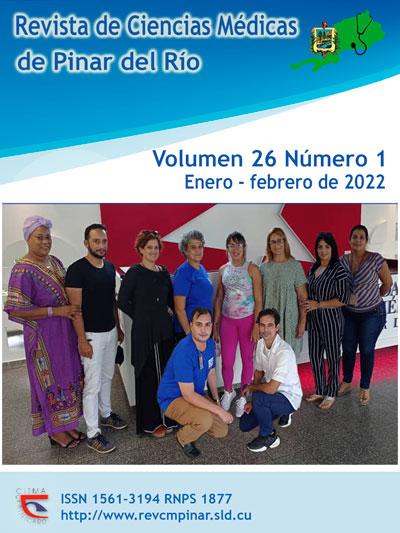Evolution of a patient with hypoacusis associated with Goldenhar's syndrome: a case report
Keywords:
HEARING LOSS, GOLDENHAR SYNDROME, ORAL LANGUAGE, REHABILITATION.Abstract
Introduction: Goldenhar’s syndrome is a congenital polymalformative syndrome that is evident at birth. It is a malformation of the facial-auriculo-vertebral spectrum, which has associated auricular anomalies in the sections of the auditory canal, causing bilateral mixed hearing loss in about one third of the cases. For its satisfactory rehabilitation it requires the participation of a multidisciplinary team, among them: pediatricians, audiologists, plastic surgeons, ophthalmologists and speech-language therapists.
Case report: a 3-year old and 10 months preschooler, who was evaluated at the Speech Therapy Laboratory of Psychomotor Skills and Early Stimulation at Pinar del Rio University at one year old for presenting delay of language development. A pediatric speech-language clinical history was written, including positive physical examination data such as severe bilateral microtia grade IV in the right ear and almost anotia in the left ear, hemi-facial microsomia, left unilateral macrostomia with deviation of the labial commissure to the left and appendiceal appendages in the path of the first and second branchial arch. The auditory study determined moderate to severe mixed sensorineural hearing loss in the right ear and profound sensorineural hearing loss in the left ear.
Conclusions: children from early infancy with hearing loss associated with Goldenhar´s syndrome have a successful evolution, taking into account the earliest possible diagnosis and intervention. The study allowed the description of a case with hearing loss associated with Goldenhar´s syndrome, which revealed a good development of expressive and comprehensive language.
Downloads
References
1. Agredo FE, Cuello G, Blanco P. Síndrome de Golden Har. Reporte de un caso. Acta otorrinolaringolcir cabeza cuello [Internet]. 2009 [citado 17/07/2021]; 37(4): 215-9. Disponible en: https://revista.acorl.org.co/index.php/acorl/article/view/302
2. Jorge Junior JJ, Zafiro M BR. Síndrome de Goldenhar. Revista Da Faculdade De Ciências Médicas De Sorocaba [Internet]. 2019 [citado 3/11/2021]; 21(Supl.). Disponible en: https://revistas.pucsp.br/index.php/RFCMS/article/view/46240
3. Lakshman AR, Subhas BG, Castelino RL, et al. Goldenhar syndrome: A case report with review of literature. MOJ Biol Med [Internet]. 2017 [citado 01/08/2021]; 1(1):18–20. Disponible en: https://medcraveonline.com/MOJBM/goldenhar-syndrome-a-case-report-with-review-of-literature.html
4. Beleza Meireles A, Hart R, Clayton Smith J, et al. Oculo-Auricu-Vertebarl Spectrum: Clinical and Molecualr Analysis of 51 Patients. Eur J Med Genet [Internet]. 2015 [citado 3/11/2021]; 58(9): 455-65. Disponible en: https://www.sciencedirect.com/science/article/abs/pii/S1769721215300069
5. Torres Salinas C. Síndrome de Goldenhar. Manifestaciones clínicas y revisión de literatura. Pediátr Panamá [Internet]. 2020 [citado 17/07/2021]; 49(1): 17-20. Disponible en: https://docs.bvsalud.org/biblioref/2020/12/1123255/1591-pdf-2101-1-10-20201015.pdf
6. Álvarez-Buylla Blanco M, Pérez Fernández ME, Campuzano Álvarez J, Padín Seara A, Vázquez Barro JC. Caso clínico. Síndrome óculo-aurículo-vertebral esporádico y hereditario
Acta Otorrinolaringol. Gallega [Internet]. 2014 [citado 17/07/2021]; 7(1):30-36. Disponible en: http://www.sgorl.org/revista/images/goldenhar_4-08-2014.pdf
7. Quantin P, Bernáldez G, Morales ME, González Macchi S, Draghi P, Sommerfleck M De Bagge. Malformaciones del oído externo y medio en Pediatría: Características clínico audiológicas y tratamiento. Revista Medicina Infantil [Internet]. 2018 [citado 20/09/2021];
XXV (2): e078. Disponible en: https://www.medicinainfantil.org.ar/images/stories/volumen/2018/xxv_2_078.pdf
8. Desai V. Oculo-auriculo-vertebral spectrum with radial defects,
a bifid condyle and taurodontism: A case report. DentMed Probl [Internet]. 2019 [citado 20/09/2021]; 56(4):427–431. Disponible en: https://pubmed.ncbi.nlm.nih.gov/31689014/
9. Guevara Valmaña OI, Nahas Combina L, Andrade Delgado L, Apellaniz Campo AG, Leyva Sotelo LM, Gaspar Daniel A. Síndrome de Goldenhar: protocolo de manejo quirúrgico en un centro de referencia. Cir Cir [Internet]. 2019 [citado 21/10/2021]; 87(5): 516-527. Disponible en: https://www.medigraphic.com/cgi-bin/new/resumen.cgi?IDARTICULO=88913
10. Baraquiso Pazos M, Guier Bonilla L. Hipoacusia infantil, déficit sensorial frecuente. Revista Médica Sinergia [Internet]. 2020 [Citado 3/11/2021]; 5(9): e576. Disponible en: https://revistamedicasinergia.com/index.php/rms/article/view/576
11. Jahanimoghadam F. Goldenhar Syndrome in a 6-Year-Old Patient: a Case Report and Review of Literature. J Dent (Shiraz) [Internet]. 2019 [Citado 3/11/2021]; 20(4): 298–303. Disponible en: https://www.ncbi.nlm.nih.gov/pmc/articles/PMC6890820/
12. Villamayor W, Ruiz-Díaz O, Zárate K, Saucedo M, Tandi L, Sánchez P, et al. Malformaciones congénitas del oído externo y medio en pacientes de la Cátedra de Otorrinolaringolo-gía, Facultad de Ciencias Médicas, Universidad Nacional de Asunción, Paraguay. Medicina Clínica y Social [Internet]. 2017 [Citado 3/11/2021]; 1(2):105-113. Disponible en: https://medicinaclinicaysocial.org/index.php/MCS/article/view/14/21
13. Lakshman AR, Subhas BG, Castelino RL, et al. Goldenhar syndrome: A case report with review of literature. MOJ BiolMed [Internet]. 2017 [Citado 10/10/2021]; 1(1):18‒20. Disponible en: https://medcraveonline.com/MOJBM/goldenhar-syndrome-a-case-report-with-review-of-literature.html
14. Jácome Cambisaca PA, Torres Zúñiga GJ, Vanegas Bravo MA. Visión retrospectiva de la hipoacusia por microtia, servicio de audiología, hospital Vicente Corral Moscoso. Enero 2015 Enero 2020. Cuenca 2021 [Internet]. Cuenca, Ecuador; 2021 [Citado 3/11/2021]. Disponible en: http://dspace.ucuenca.edu.ec/bitstream/123456789/36768/1/PROYECTO%20DE%20INVESTIGACION_1317TM.pdf
Downloads
Published
How to Cite
Issue
Section
License
Authors who have publications with this journal agree to the following terms: Authors will retain their copyrights and grant the journal the right of first publication of their work, which will be publication of their work, which will be simultaneously subject to the Creative Commons Attribution License (CC-BY-NC 4.0) that allows third parties to share the work as long as its author and first publication in this journal are indicated.
Authors may adopt other non-exclusive license agreements for distribution of the published version of the work (e.g.: deposit it in an institutional telematic archive or publish it in a volume). Likewise, and according to the recommendations of the Medical Sciences Editorial (ECIMED), authors must declare in each article their contribution according to the CRediT taxonomy (contributor roles). This taxonomy includes 14 roles, which can be used to represent the tasks typically performed by contributors in scientific academic production. It should be consulted in monograph) whenever initial publication in this journal is indicated. Authors are allowed and encouraged to disseminate their work through the Internet (e.g., in institutional telematic archives or on their web page) before and during the submission process, which may produce interesting exchanges and increase citations of the published work. (See The effect of open access). https://casrai.org/credit/



